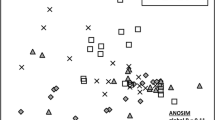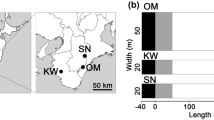Abstract
Willows (Salix spp.) are mycorrhizal tree species sometimes cultivated as short rotation coppice (SRC) on arable sites for energy purposes; they are also among the earliest plants colonising primary successional sites in natural stands. The objective of this study was to analyse the degree of colonisation and diversity of ectomycorrhizal (EM) communities on willows grown as SRC in arable soils and their adjacent natural or naturalized stands. Arable sites usually lack ectomycorrhizal host plants before the establishment of SRC, and adjacent natural or naturalized willow stands were hypothesized to be a leading source of ectomycorrhizal inoculum for the SRC. Three test sites including SRC stands (Salix viminalis, Salix dasyclados, and Salix schwerinii) and adjacent natural or naturalized (Salix caprea, Salix fragilis, and Salix × mollissima) stands in central Sweden were investigated on EM colonisation and morphotypes, and the fungal partners of 36 of the total 49 EM fungi morphotypes were identified using molecular tools. The frequency of mycorrhizas in the natural/naturalized stands was higher (two sites) or lower (one site) than in the corresponding cultivated stands. Correspondence analysis revealed that some EM taxa (e.g. Agaricales) were mostly associated with cultivated willows, while others (e.g. Thelephorales) were mostly found in natural/naturalized stands. In conclusion, we found strong effects of sites and willow genotype on EM fungi formation, but poor correspondence between the EM fungi abundance and diversity in SRC and their adjacent natural/naturalized stands. The underlying mechanism might be selective promotion of some EM fungi species by more effective spore dispersal.



Similar content being viewed by others
References
Agerer R (ed) (1987–2002) Colour atlas of Ectomycorrhizae, 1st–12th edn. Einhorn, Schwabisch Gmund
Agerer R (1991) Ectomycorrhizae of Sarcodon imbricatus on Norway spruce and their chlamydospores. Mycorrhiza 1:21–30
Alexandersson H, Karlström C, Larsson-McCann S (1991) Temperature and precipitation in Sweden 1961–1990. Reference normals. SMHI Meteorol 81:1–88
Altschul SF, Gish W, Miller W, Myers EW, Lipman DJ (1990) Basic Local Alignment Search Tool. J Mol Biol 215:403–410
Baum C, Makeschin F (2000) Effects of nitrogen and phosphorusonmycorrhizal formation of two poplar clones (Populus trichocarpa and P. tremula × tremuloides). J Plant Nutr Soil Sci 163:491–497
Baum C, Weih M, Verwijst T, Makeschin F (2002) The effects of nitrogen fertilization and soil properties on mycorrhizal formation of Salix viminalis. For Ecol Manag 160:35–43
Baum C, Hrynkiewicz K, Leinweber P, Meissner R (2006) Heavy metal mobilization and uptake by mycorrhizal and non-mycorrhizal willows (Salix × dasyclados). J Plant Nutr Soil Sci 169:516–522
Baum C, Leinweber P, Weih M, Lamersdorf N, Dimitriou I (2009a) Effects of short rotation coppice with willows and poplar on soil ecology, Landbauforschung – vTI. Agric Forest Res 59:183–196
Baum C, Toljander YK, Eckhardt K-U, Weih M (2009b) The significance of host-fungus combinations in ectomycorrhizal symbioses for the chemical quality of willow foliage. Plant Soil 323:213–224
Burnett J (2003) Fungal population and species. Oxford University Press, Oxford
Clemmensen KE, Michelsen A (2006) Integrated long-term response of an arctic-alpine willow and associated ectomycorrhizal fungi to an altered environment. Can J Bot 84:831–843
Deacon JW, Fleming LV (1992) Interactions of ectomycorrhizal fungi. In: Allen MF (ed) Mycorrhizal functioning an integrative plant-fungal process. Chapman and Hall, New York, pp 249–300
Erland S, Taylor AFS (2002) Diversity of ecto-mycorrhizal fungal communities in relation to the abiotic environment. In: van der Heijden MGA, Sanders IR (eds) Mycorrhizal ecology. Springer, Berlin, pp 163–200
Gardes M, Bruns TD (1993) ITS primers with enhanced specificity of basidiomycetes: application to the identification of mycorrhizae and rusts. Mol Ecol 2:113–118
Haug I (2002) Identification of Picea-ectomycorrhizae by comparing DNA-sequences. Mycol Prog 1:167–178
Hrynkiewicz K, Baum C (2012) The potential of rhizosphere microorganisms to promote the plant growth in disturbed soils. In: Malik A, Grohmann E (eds) Environmental protection strategies for sustainable development. Springer, Berlin, pp 35–64
Hrynkiewicz K, Haug I, Baum C (2008) Ectomycorrhizal community structure under willows at former ore mining sites. Eur J Soil Biol 44:37–44
Hrynkiewicz K, Baum C, Niedojadło J, Dahm H (2009) Promotion of mycorrhiza formation and growth of willows by the bacterial strain Sphingomonas sp. 23L on fly ash. Biol Fertil Soils 45:385–394
Hrynkiewicz K, Ciesielska A, Haug I, Baum C (2010a) Ectomycorrhiza formation and willow growth promotion as affected by associated bacteria: role of microbial metabolites and use of C sources. Biol Fertil Soils 46:139–150
Hrynkiewicz K, Baum C, Leinweber P, Weih M, Dimitriou I (2010b) The significance of rotation periods for mycorrhiza formation in short rotation coppice. For Ecol Manag 260:1943–1949
Jonsell B (ed) (2000) Flora Nordica 1. The Royal Swedish Academy of Sciences, Stockholm
Jumpponen A (2011) Analysis of ribosomal RNA indicates seasonal fungal community dynamics in Andropogon gerardii roots. Mycorrhiza 21:453–464
Jumpponen A, Trappe JM (1998) Performance of Pinus contorta inoculated with two strains of root endophytic fungus Phialocephala fortinii: effects of resynthesis system and glucose concentration. Can J Bot 76:1205–1213
Knudsen H (2006) Mycology in Greenland. In: Boertmann D, Knudsen H (eds) Arctic and Alpine Mycology 6. Bioscience (Meddeleser om Gronland) 56:7–16
Koljalg U, Larsson K-H, Abarenkov K, Nilsson RH, Alexander IJ, Eberhardt U, Erland S, Hoiland K, Kjoller R, Larsson E, Pennanen T, Sen R, Taylor AFS, Tedersoo L, Vralstad T, Ursing BM (2005) UNITE: a database providing webbased methods for the molecular identification of ectomycorrhizal fungi. New Phytol 166:1063–1068
Krpata D, Peintner U, Langer I, Fitz WJ, Schweiger P (2008) Ectomycorrhizal communities associated with Populus tremula growing on a heavy metal contaminated site. Mycol Res 112:1069–1079
Kuzovkina Y, Weih M, Abalos Romero M, Belyaeva I, Charles J, Hurst S, Karp A, Labrecque M, McIvor I, Singh NB, Smart L, Teodorescu T, Trybush S, Volk T (2008) Salix: botany and global horticulture. Horticult Rev 34:447–489
Larsson S (1998) Genetic improvement of willow for short-rotation coppice. Biomass Bioenergy 15:23–26
Lilleskov EA, Bruns TD (2005) Spore dispersal of a resupinate ectomycorrhizal fungus, Tomentella sublilacina, via soil food webs. Mycologia 97:762–769
Mason PA, Wilson J, Last FT, Walker C (1983) The concept of succession in relation to the spread of sheathing mycorrhizal fungi on inoculated tree seedlings growing in unsterilized soils. Plant Soil 71:247–256
Murat C, Vizzini A, Bonfante P, Mello A (2005) Morphological and molecular typing of the below-ground fungal community in a natural Tuber magnatum truffle-ground. FEMS Microbiol Lett 245:307–313
Nara K (2006) Ectomycorrhizal networks and seedling establishment during early primary succession. New Phytol 169:169–178
Nara K, Nakaya H, Wu B, Zhou Z, Hogetsu T (2003) Underground primary succession of ectomycorrhizal fungi in volcanic desert on Mount Fuji. New Phytol 159:743–756
Nordh NE, Verwijst T (2004) Above-ground biomass assessments and first cutting cycle production in willow (Salix sp.) coppice—a comparison between destructive and non-destructive methods. Biomass Bioenergy 27:1–8
Parádi I, Baar J (2006) Mycorrhizal fungal diversity in willow forests of different age along the river Waal, The Netherlands. For Ecol Manag 237:366–372
Pei MH, Ruiz C, Hunter T, Bayon C (2003) Rust resistance in Salix induced by inoculations with avirulent and virulent isolates of Melampsora larici-epitea. For Path 33:383–394
Peintner U, Bougher NL, Castellano MA, Moncalvo J-M, Moser MM, Trappe JM, Vilgalys R (2001) Multiple origins of sequestrate fungi related to Cortinarius (Cortinariaceae). Am J Bot 88:2168–2179
Püttsepp Ü, Rosling A, Taylor AFS (2004) Ectomycorrhizal fungal communities associated with Salix viminalis L. and S. dasyclados Wimm. clones in a short-rotation forestry plantation. For Ecol Manag 196:413–424
Rooney DC, Killham K, Bending GD, Baggs E, Weih M, Hodge A (2009) Mycorrhizas and biomass crops: opportunities for future sustainable development. Trends Plant Sci 14:542–549
Roy M, Dubois M-P, Proffit M, Vincenot L, Desmarais E, Selosse MA (2008) Evidence from population genetics that the ectomycorrhizal basidiomycete Laccaria amethystina is an actual multihost symbiont. Mol Ecol 17:2825–2838
Shiryaev A (2009) Diversity and distribution of clavarioid fungi in Estonia. Folia Cryptog Estonica Fasc 45:65–80
van der Heijden EW, Kuyper TW (2003) Ecological strategies of ectomycorrhizal fungi of Salix repens: root manipulation versus root replacement. Oikos 103:668–680
van der Heijden EW, Vries FW, Kuyper TW (1999) Mycorrhizal associations of Salix repens L. communities in succession of dune ecosystems. I. Above-ground and below-ground views of ectomycorrhizal fungi in relation to soil chemistry. Can J Bot 77:1821–1832
Weih M (2004) Intensive short rotation forestry in boreal climates: present and future perspectives. Can J For Res 34:1369–1378
Weih M, Nordh NE (2005) Determinants of biomass production in hybrid willows and the prediction of field performance from pot studies. Tree Physiol 25:1197–1206
White TJ, Bruns TD, Lee SB, Taylor JW (1990) Analysis of phylogenetic relationships by amplification and direct sequencing of ribosomal RNA genes. In: Innis MA, Gelfand DH, Sninsky JN, White TJ (eds) PCR protocols: a guide to methods and applications. Academic, New York, pp 315–322
Acknowledgments
The field assistance by Lenny Van Bussel is greatly acknowledged. The work received financial support from the Swedish Research Council for Environment, Agricultural Sciences and Spatial Planning (Formas).
Author information
Authors and Affiliations
Corresponding author
Rights and permissions
About this article
Cite this article
Hrynkiewicz, K., Toljander, Y.K., Baum, C. et al. Correspondence of ectomycorrhizal diversity and colonisation of willows (Salix spp.) grown in short rotation coppice on arable sites and adjacent natural stands. Mycorrhiza 22, 603–613 (2012). https://doi.org/10.1007/s00572-012-0437-z
Received:
Accepted:
Published:
Issue Date:
DOI: https://doi.org/10.1007/s00572-012-0437-z




